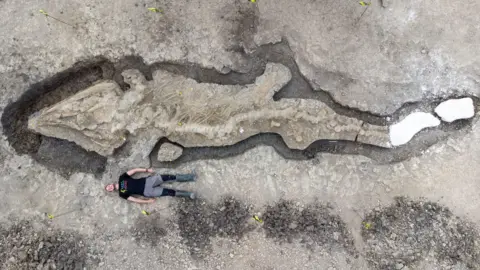Why do giant sea dragons keep being found inland?
 Anglian Water
Anglian WaterUndiscovered "sea dragons" are lurking underneath the feet of Leicestershire and Rutland residents, an expert has said.
Ichthyosaur specialist Dr Dean Lomax said recent discoveries of the vast marine reptiles which swam the seas of the Jurassic period in the two counties could pave the way for marking the East Midlands as an unlikely hotspot.
Traditionally, ichthyosaurs are discovered along coastlines, usually because of erosion exposing evidence of the reptile remains.
But 2021's discovery of a 10m-long predator fossil - the largest of its type ever discovered in the UK - and the unearthing of a fragment of ichthyosaur skull on the route of the new Melton bypass road this year have made experts look at the area in a new light.
While the coastlines of Yorkshire and Dorset are best known for producing evidence of ichthyosaurs and the dinosaurs that roamed the land at the same time, the two share a common geology - and this runs between the two points, directly through the East Midlands.
Some 140 to 200 million years ago, the whole area would have been largely a shallow sea, with islands to support reptiles on land and in the air as well as marine life.
But where coastline finds from this period are more abundant, the discoveries made inland stand much greater chances of being complete.
 PA Media
PA MediaDr Lomax, a palaeontologist with the University of Bristol and University of Manchester, said: "At the Yorkshire coastline or the Jurassic coastline, often you just have partial skeletons or complete skeletons that are eroding out.
"You've got cliff faces erosion. You've got the sea floor that's been eroded away. And so if you've had a beautiful skeleton there once, in many cases, those bones have become scattered, and you'll have isolated bits and pieces and maybe 50 different collectors will have parts of the skeleton.
"If you have an inland location, like the Rutland sea dragon, there's always a good chance you'll have something complete."

Finds in Leicestershire and Rutland are not a recent phenomenon.
Dr Lomax said documented Jurassic finds from quarries in the area go back about 200 years.
But the recent finds, such as the two ichthyosaur specimens and the first-ever Bajocian pterosaur identified in Ketton, have helped experts to re-evaluate the region.
Dr Lomax said: "It's really become a hotspot, and it's definitely changed my perception of that area, and the potential that it has for the future, for more amazing discoveries.
"There's a lot of material that could be found. And I'm sure it will be found.
"There are many, many, many specimens sitting under the feet of people now who are sitting in their houses, or working, living across Leicestershire and the neighbouring areas, Jurassic aged marine reptiles, and almost certainly dinosaurs as well."
Follow BBC Leicester on Facebook, on X, or on Instagram. Send your story ideas to [email protected] or via WhatsApp on 0808 100 2210.
